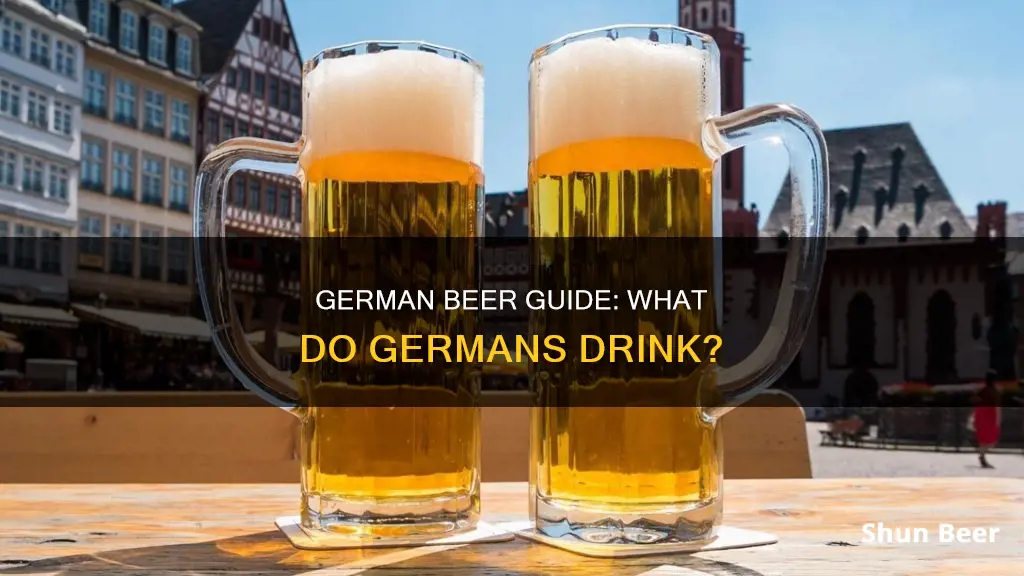
Germany is known for its beer, with over 1,500 breweries producing around 5,000 types of beer. The country's beer-making process is governed by a food purity law passed in 1516, which states that only barley, malt, hops and water are allowed.
While Germany is known for its lagers, it also produces a wide variety of other beers, including pilsners, wheat beers, bocks, smoked beers, and alcohol-free beers.
Most Germans tend to stick to their local beer, but some of the country's most popular brands include Krombacher, Warsteiner, Bitburger, Radeberger, and Beck's.
What You'll Learn

German beer purity law
In April 1516, Bavarian Duke Wilhelm IV issued the Beer Purity Law, or the Reinheitsgebot, stipulating that only water, barley, and hops were permitted to be used as key ingredients in beer production. This law, which is the world's oldest food safety law still in existence, formed the core of the German Beer Purity Laws that continue to influence brewing today.
The original 1516 Bavarian law stated that the only ingredients allowed in beer were malt (germinated, dried barley), hops, and water. While the properties of yeast were unknown at the time, it was later included as an important fourth ingredient when its role in achieving fermentation was recognised in the 19th century. Wheat was also eventually permitted, though it was initially reserved for baking bread.
The Bavarian law was introduced, in part, to prevent price competition with bakers for wheat and rye. By restricting grains to barley, the availability of affordable bread was ensured. The rule may have also played a protectionist role, as beers from Northern Germany often contained additives that could not be grown in Bavaria. Additionally, religious conservatism may have influenced the adoption of the rule, as it suppressed the use of plants allegedly used in pagan rituals.
The law was enacted due to brewers using unsavoury and dangerous ingredients to adulterate and stretch beer, which was considered a basic foodstuff. The regulations were later adopted across Germany and have survived numerous iterations. All traditional German beers are brewed within the law, with some exceptions made for regionally historic styles.
The Reinheitsgebot remains influential in brewing not only in Germany but worldwide. It is considered a sign of purity and transparency by German brewers, who have used it to market German beer internationally. While some critics argue that it has slowed Germany's adoption of beer trends from the rest of the world, many craft brewers feel that creativity is not restricted by the law, as there is huge diversity within the four permitted ingredients.
Wisconsin's Open Container Law: Beer and Cars
You may want to see also

Local breweries
Germany has a strong culture of drinking local beers, with most people growing up with a preference for the beer brewed in their region. Here are some of the best local breweries in Germany:
Andechs Monastery
Andechs Monastery is a fantastic way to spend an afternoon. In addition to the architectural beauty of the monastery itself, visitors can enjoy excellent food and beer at great value for money. It is located on a "holy mountain" near Herrsching, offering a rewarding hike for those willing to make the trip.
Landskron Braumanufaktur
Landskron Braumanufaktur is one of the best breweries in Germany, according to visitors. The brewery tour includes interesting historical information and a degustation of their beers. The staff are friendly and speak excellent English.
Paulaner Brewery
The Paulaner Brewery offers a fun and educational experience, providing insight into the unique design of the site. The product is an amazing wheat beer, and there are additional beers on tap. The biergarten and tap room are perfect for large groups, and the view from the top of the tower is outstanding.
Ayinger Brewery
The Ayinger Brewery offers a very interesting tour, including a film with gimmicks from the past and a train ride through the beer plant. The staff are friendly and speak English well. After the tour, visitors can enjoy two hours of free beer and pretzels.
Warsteiner Welt
Warsteiner Welt is a great destination for a hot day. The staff are friendly and speak excellent English. The tour includes a film, gimmicks from the past, and a train ride through the beer plant. Visitors can also enjoy free beer and pretzels after the tour.
Alpirsbacher Klosterbraeu
Alpirsbacher Klosterbraeu offers a fascinating glimpse into the history of beer-making. The tour includes a film and a train ride through the beer plant. Visitors can also sample two beers of their choice, along with an earthenware beer tankard to take home as a souvenir.
Good Friday Beer: Is It Allowed?
You may want to see also

Beer and food pairings
While Germans tend to favour their local beers, there are some German beer styles that are universally recognised and loved. These include the mighty lager, the fruity hefeweizen, and the crisp kölsch.
Pairing Beer with Food
When pairing beer with food, there are four guidelines to consider: contrast, complement, cleanse, and avoid overpowering flavours.
Contrast
To make a good contrast pairing, choose a beer or dish with one strong, dominant flavour, such as sweet, rich, or oily. For example, oysters and stout is a good contrast pairing because the oysters' strong, briny flavour can stand up to the rich texture and chocolate notes of the stout.
Complement
Complementing flavours is a simple way to make a delicious pairing. Match rich foods with heavy and rich-flavoured beers like stouts or porters. Pair light-tasting salads and fish with light beers, and wheat beers with fruit tarts.
Cleanse
Beer can also serve as a palate cleanser, which is particularly well-suited for dishes with bold or intense flavours, such as spicy Indian cuisine or rich fried foods. A crisp and refreshing light beer can wash down the heat of Korean fried chicken, for example. This technique can also be reversed, where fatty foods like French fries or nuts can help balance out the bitterness of an IPA.
Avoid Overpowering Flavours
Be mindful of the levels of flavour in your food and beer. Medium and dark beers, for instance, have rich and powerful flavours that can overpower certain types of food. Pairing salmon with a pint of Guinness would not be ideal, as the flavour of the beer would completely cover the taste of the fish.
Pairing German Beer Styles with Food
Light Lagers
Spicy food, burgers, and salads are ideal pairings for light lagers, which are known for their crisp and refreshing taste.
Wheat Beers
Wheat beers are very versatile and can be paired with many foods, including spicy dishes and fruity desserts.
India Pale Ales (IPAs)
IPAs work well with steak, barbecue, and Mexican food.
Amber Ales
Pair amber ales with pizza, fried food, or smoked pork.
Dark Lagers
Dark lagers are excellent complements to hearty traditional European dishes, such as pizza and burgers.
Brown Ales
Brown ales are versatile and pair well with almost anything, including sausage, sushi, and fish.
Porters
Rabbit, venison, game meats, seafood, coffee-flavoured desserts, and rich roasted flavours are good matches for porters.
Stouts
Stouts are perfect for pairing with chocolate desserts, shellfish, and Mexican food.
Root Beer Cocktails: Strong Alcohols for a Hard Kick
You may want to see also

Beer gardens
History
Food and Drink
- Schnitzel: Boneless meat that is breaded and fried.
- Bratwurst: Grilled pork sausage traditionally served with mustard.
- Pretzels: Enjoy the original German recipes used to make the most authentic pretzels in the world.
- Spittle: Egg noodles tossed in butter, usually served as a side dish or snack.
- Obatzda: Bavarian cheese spread made to accompany beer, served with rye bread or Bavarian soft pretzels.
- Hefeweizen: Wheat beer that is sweet, cloudy, holds average alcohol content, and some yeast sediment. It is usually flavoured with fruit, coriander, or orange peel.
- Pilsner: Lager beer that's golden, bitter, and has a light citrus flavour.
- Kusch: Clear pale ale with noticeably less bitterness than the pilsner.
- Dunkel: Dark amber lager native to Munich. It is malty, but smooth without heaviness.
- Märzen: Dark lager with medium alcohol content and a full body.
Popular Beer Gardens in Germany
- Augustiner Keller: The oldest beer garden in Munich, established in 1812 and run by the Augustiner Bräu brewery.
- Hirschgarten: The largest beer garden in the world, with seating for up to 8,000 people.
- Hofbräuhaus: Technically not an outdoor beer garden, this is a historical precursor for the beer garden structure. It was built in the late 16th century as a private drinking yard for the Duke of Bavaria. Today, it is a popular public drinking hall that can fit over 1,000 people.
- Aumeister: Located in the English Garden, this gigantic beer garden was once a waterhole for the Duke's royal hunting company.
- Chinesischer Turm: The second-largest beer garden in Munich, located just outside the 82-foot Chinese Tower. It can hold up to 7,000 people and offers self-service options.
Beer and Atkins: What Brews Can You Enjoy?
You may want to see also

Beer styles and varieties
Germany has over 7,000 varieties of beer, brewed in 1,300 breweries. A good fifth of these are found in the southern region of Bavaria, whose capital, Munich, is home to the world-famous Oktoberfest beer festival.
Pilsner
Pilsner is a relatively latecomer to the beer scene, created in around 1842 by German brew master Josef Groll in the town of Pilsen, Bohemia, now in the Czech Republic. Pilsner has about 4.0–5.2% alcohol, is bottom-fermented, light-coloured, and has a distinctly bitter, ‘hoppy’ note and aroma. Leading brands include Krombacher, Warsteiner, Bitburger and Radeberger.
Helles or Dunkles Lager
Helles is considered a working-class type of beer, originating in Munich and Dortmund, and usually consumed in steins or large glasses, in beer halls or intimate pubs. This bottom-fermented beer has more pronounced malt notes, comes in light or dark colour depending on the degree to which the malt was roasted, is less bitter, and has about 4.5% alcohol. Among the well-known brands are Löwenbräu, Hofbräu, and Dortmunder Aktienbrau (DAB).
Export Lager
Export lager is a bottom-fermented beer like Helles, but was originally made in the mid-19th century to ship overseas. It has a wort content of 12–14%, meaning stronger malt flavours, and a bit higher alcohol content of over 5%. Well-known brands include Dortmund and Munich Export beers, but none has achieved more global recognition than Beck’s Beer from Bremen, founded in 1876.
Kölsch and Alt
These two distinct beers are intimately connected to the cities on the Rhine river — Köln/Cologne (Kölsch) and Düsseldorf (Alt). These beers are top-fermented, with a balanced flavour, 4.8% alcohol and a really smooth finish. Served in cylindrical, narrow glasses, Kölsch and Alt are typically downed and replenished in minutes. Kölsch is made from light malt; Altbier is made from darker roasted malt and is consequently a bit more bitter. Both beers attained the coveted EU status of “Protected Designation of Origin” (PDO), so no brewery in the European Union can produce Kölsch or Alt outside the Cologne or Düsseldorf regions. Famous brands include Früh Kölsch and Diebels Alt.
Weißbier (Wheat Beer): Kristall, Hefe and Dark
Primarily consumed in Southern Germany, this top-fermented beer has 5–5.8% alcohol, a refreshing, zesty flavour, and is served in tall slender glasses. The malt is part barley, part wheat. Pouring a Weißbier from a bottle is a tricky business. First, the glass is dipped in water. Then you have to tilt the glass as far as possible and slowly “pull” the suds from the bottom to the top of the glass. Otherwise, you only get masses of overflowing beer foam. Weissbier comes in Kristall (clear colour, filtered), Hefe (cloudy, yellow colour, some wheat and yeast residues), and Dunkel (roasted dark malt). Munich insiders would recommend Schneider Weisse or Augustiner Weisse as favourite brands.
Starkbier or Bockbier
This full-bodied beer is a Southern German favourite, traditionally brewed in March for consumption during Lent, with a minimum of 16% wort and about 7%+ alcohol content. The colour ranges from golden to very dark. If you happen to be in Munich at the beginning of March, try to catch the opening of the Salvator-Anstich, the keg opening at the Nockherberg Starkbier festival. There you can enjoy Starkbier with up to 17% alcohol content.
Schwarzbier
For most of the past seven millennia, beer was a dark-coloured beverage. It’s less than 200 years since brewers have used lightly malted barley to create light-coloured beers like Helles, Kölsch or Pilsner. Schwarzbier is Germany's Guinness, primarily consumed in Thuringia and Saxony. Bottom-fermented, full-bodied, lightly sweet and malty, it has about 11% wort and 4.8% alcohol content. Köstritzer Schwarzbier is a famous brand. This beer is best consumed at 8º Celsius in a chalice-type glass.
Berliner Weisse – Red or Green
This is a refreshing, fruity, wheat beer originating about 300 years ago in Germany’s capital city. Berliner Weisse became a hit in the summer beer gardens of 19th-century Berlin. In contrast to Munich wheat beer, Berliner Weisse has about 7% wort and only 2.4% alcohol content and is fermented with a mix of brewers' yeast and lactic acid bacteria. Thus, the beer gets a lightly tart, crisp flavour that is sweetened with raspberry (red) or woodruff (green) extract. A hot summer month favourite consumed in wide-bodied glasses.
Märzen or Oktoberfestbier
This bottom-fermented beer is similar to Helles, but with a minimum of 13% wort and 4.8–5.6% alcohol content. Traditionally brewed in March, since prior to the mid-19th century breweries were required to shut down for the summer. This beer is also served during the famous Munich Oktoberfest. With soft malty notes, Märzen is pleasant to drink, and is typically consumed in steins in beer halls.
Gose
A specialty wheat beer originating in the city of Goslar near the Harz Mountains. Like Berliner Weisse, this top-fermented beer is fermented with yeast and lactic acid bacteria, giving it a lightly sour note. Curiously, salt and coriander are added during the brewing process. Gose became very You may want to see also The most popular beer types in Germany include lagers, pilsners, hefeweizens, and wheat beers. Some popular German beer brands include Krombacher, Warsteiner, Bitburger, Radeberger, Beck's, Erdinger, and Augustiner. German beers are known for their high quality and adherence to the German purity law, allowing only barley, malt, hops, and water in the brewing process. German beers offer a range of flavours, from crisp and bitter pilsners to fruity and spicy wheat beers.Drinking Beer While Taking Lisinopril: What You Need to Know
Frequently asked questions







